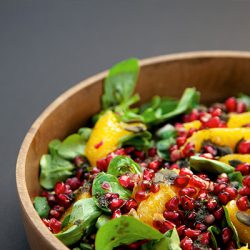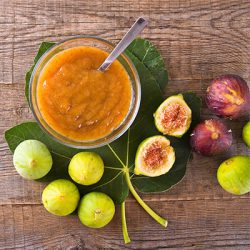Get Cooking with the Fruits and Vegetables of Tu B’shevat

At a time in the year when it is cold, dark and snowy, we celebrate the birthday of the trees, Tu B’shevat. While this holiday does not get as much fanfare as other winter holidays Hanukkah or Purim there are lots of lessons to be learned.
Tu B’shevat celebrates fruits and grains that all come with their own uniqueness and individuality. This is the ultimate holiday of community as we take the different fruits and grains and bring them together for a beautiful Tu B’shevat celebration (recipes below).
The holiday begins with the pomegranate, a fruit that takes hard work to get to the seeds. Pomegranates have a very hard outer shell and you have to be skilled and thoughtful to get into the shell to get the seeds out. They teach us that not everyone wears their heart on their sleeve and it’s often needed to have thoughtful conversations and the patience to listen to get to know someone.

Next on the Tu B’shevat table are dates and olives. Dates and olives are edible on the outside but have seeds on the inside. Often when someone eats a date or an olive they just throw the pit away without even thinking about it. It’s easy to throw that part away because it’s inedible, but pits are actually seeds and can be planted to create something new. Olives and dates represent that everyone has something to teach us and everyone is a creator and innovator in their own way.
Grapes and figs are the next fruits on our Tu B’shevat table. These fruits can be eaten whole and without any effort. They remind us of the wholeness of people and bringing our whole self to conversations, interactions and experiences. These fruits remind us of how to be vulnerable and share ourselves with others.

Lastly to celebrate Tu B’shevat, we use wheat and barley as part of the celebration. Both grow tall and are seen as representing kindness. These grains teach us that all relationships begin with empathy. Empathy is not just understanding someone’s feelings, but really imagining how that person might feel at a given moment. When we can show empathy and kindness to others we can strengthen relationships and community.
The lessons of Tu B’shevat are many, but as we celebrate this year let’s connect and learn from each other, remember our own uniqueness and create a community just as beautiful as the fruits of our Tu B’shevat table.
Try some of these delicious recipes using fruits from the Tu B’shevat table. They were provided to us from our community.
Brown Rice Salad with Pomegranates, Dates and Orange
By CJE Connector Leia Neft
Ingredients
- 3 cups cooked dark brown rice (1cup uncooked)
- 16 dates (pitted and diced)
- 1/2 cup pomegranate seeds
- 2 large navel oranges (peeled, divided into segments, each segment cut into thirds)
- 2 scallions (minced)
- 1⁄4 cup dark or golden raisins (or craisins)
- 1⁄4 cup minced fresh parsley
- 1/4-1/2 cups slivered almonds
- 1⁄4 cup extra-virgin olive oil
- 2 Tbsp fresh lemon juice 1⁄4 tsp ground cinnamon
- 1⁄4 tsp ground cumin
- Pinch of red pepper flakes
- Salt to taste
Stir all ingredients together in large bowl.
Fig Compote
Courtesy of Pearlstone Kitchen
Ingredients
- 1 cup whole dried figs, chopped
- ½ cup apple juice
- ¼ cup apple cider vinegar
- ¼ cup sugar
Simmer slowly until tender and reduced to desired consistency.
Kohlrabi Salad with Leeks and Plums
Courtesy of Pearlstone Kitchen
Ingredients
- 3 medium kohlrabi
- 1 Leek, sliced, sauteed
- 2 plums, sliced
- 1/3 cup plain Greek yogurt
- 3 Tbsp sour cream
- 3 Tbsp cream cheese
- 2 Tbsp garlic confit
- ½ tsp fresh lime juice
- 1 Tbsp fresh mint, chiffonade
- 1 cup arugula
- 1 Tbsp sumac
Directions
- Peel kohlrabi and cut into 1-inch cubes. Set aside.
- To make the dressing combine yogurt, sour cream, cream cheese, smashed garlic confit and lime juice.
- Toss kohlrabi, sauteed leeks and sliced plums in dressing and mix thoroughly. Fold in mint and arugula.
- Arrange on serving platter and sprinkle with sumac. Serve chilled.
Goat Cheese with Pistachios and Date Drizzle
Ingredients
- 8 oz goat cheese
- 1 cup shelled pistachios
- Commercial date syrup
Directions
- Chop pistachios to desired texture. Roll log of goat cheese in pistachios.
- Drizzle with date syrup and serve with crackers.
Carin Goren’s Date Cookies (Israeli Shinshin)
For the dough
- 3 1/2 cups flour
- 10.5 oz softened butter
- 1 Tbsp. baking powder
- 1 Tbsp vanilla sugar
- ½ cup warm water
For the spread
- 16 oz date spread
- 1 tsp cinnamon
- ¼ tsp cloves
- 1 cup chopped walnuts
To serve
Powdered sugar
Directions
- Preheat oven to 340 degrees.
- Knead all the dough ingredients in your hands to a smooth dough.
- Divide into 2 and roll each piece on floured baking paper into a rectangle 1/2 cm thick (straighten with a knife to make a rectangle with straight ribs).
- Mix date spread with cinnamon and cloves.
- Spread the dough with date spread and sprinkle with nuts. Roll into a roll and place on a baking sheet lined with baking paper.
- Make another roll from the rest of the dough (and another small one from the leftovers) in the same way.
- Bake for about 35 minutes until golden.
- Slice, sprinkle with powdered sugar and serve.
Subscribe to our newsletter
The Associated is a home for everyone in the Baltimore Jewish community. We offer several email lists to help people find a community, engage with their peers and support Jewish journeys around the world.
Join Our Mailing ListAdd Impact to Your Inbox
Sign up for our newsletter
Subscribe to our newsletter
The Associated is a home for everyone in the Baltimore Jewish community. We offer several email lists to help people find a community, engage with their peers and support Jewish journeys around the world.
Join Our Mailing List









 Please Wait while we loading your video.
Please Wait while we loading your video.